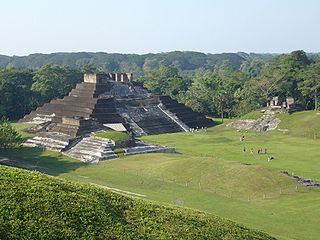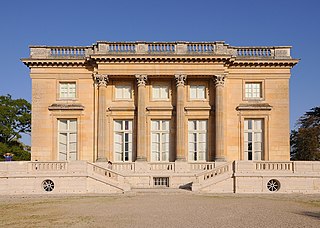
Tabasco, officially the Free and Sovereign State of Tabasco, is one of the 32 Federal Entities of the United Mexican States. It is divided into 17 municipalities and its capital city is Villahermosa.

Villahermosa is the capital and largest city of the Mexican state of Tabasco, and serves as the municipal seat of the state. Located in Southeast Mexico, Villahermosa is an important city because of its cultural history, natural resources, commercial development, and modern industrialization.

Beaux-Arts architecture was the academic architectural style taught at the École des Beaux-Arts in Paris, particularly from the 1830s to the end of the 19th century. It drew upon the principles of French neoclassicism, but also incorporated Renaissance and Baroque elements, and used modern materials, such as iron and glass, and later, steel. It was an important style and enormous influence in Europe and the Americas through the end of the 19th century, and into the 20th, particularly for institutional and public buildings.

The Royal Palace of Madrid is the official residence of the Spanish royal family at the city of Madrid, although now used only for state ceremonies. The palace has 135,000 m2 (1,450,000 sq ft) of floor space and contains 3,418 rooms. It is the largest royal palace in Europe.

The Paseo del Prado is one of the main boulevards in Madrid, Spain. It runs north–south between the Plaza de Cibeles and the Plaza del Emperador Carlos V, with the Plaza de Cánovas del Castillo lying approximately in the middle. The Paseo del Prado forms the southern end of the city's central axis. It enjoys the status of Bien de Interés Cultural (BIC), and as part of a combined UNESCO World Heritage Site with Buen Retiro Park.

Neoclassical architecture, sometimes referred to as Classical Revival architecture, is an architectural style produced by the Neoclassical movement that began in the mid-18th century in Italy, France and Germany. It became one of the most prominent architectural styles in the Western world. The prevailing styles of architecture in most of Europe for the previous two centuries, Renaissance architecture and Baroque architecture, already represented partial revivals of the Classical architecture of ancient Rome and ancient Greek architecture, but the Neoclassical movement aimed to strip away the excesses of Late Baroque and return to a purer, more complete, and more authentic classical style, adapted to modern purposes.

Churrigueresque, also but less commonly "Ultra Baroque", refers to a Spanish Baroque style of elaborate sculptural architectural ornament which emerged as a manner of stucco decoration in Spain in the late 17th century and was used until about 1750, marked by extreme, expressive and florid decorative detailing, normally found above the entrance on the main façade of a building.

Manuel Vicente Tolsá Sarrión was a prolific Neoclassical architect and sculptor in Spain and Mexico. He served as the first director of the Academy of San Carlos.

Juan de Villanueva was a Spanish architect. Alongside Ventura Rodríguez, Villanueva is the best known architect of Spanish Neoclassicism.

Duke of Villahermosa is a hereditary title in the peerage of Spain, accompanied by the dignity of Grandee and granted in 1476 by John II to Alfonso de Aragón, a half-brother of Ferdinand II.

Doña Antonia de Ipeñarrieta y Galdós and Her Son Don Luis is a 1634 portrait by Diego Velázquez, now in the Prado Museum. Doña Antonia and her son Luis are shown standing, captured in an elegant melancholy. The woman uses the chair to support herself, to emphasize her social status in the Court, where she had the right to sit. According to different studies of the canvas, it is believed that the child's figure could have been added afterwards.

The Liria Palace is a neoclassical palace in Madrid, Spain. It is the Madrid residence of the Dukes of Alba.

The Casita del Príncipe is an eighteenth-century building located in San Lorenzo de El Escorial, Spain. It was designed by the neoclassical architect Juan de Villanueva for the private use of the heir to the Spanish throne Charles, Prince of Asturias, and his wife Maria Luisa. It was constructed in the 1770s and extended in the 1780s.

José Álvarez Cubero was a Spanish sculptor in the neoclassical style. He spent a large part of his career in Paris and Rome.

Palacio de Velázquez, or Velázquez Palace is an exhibition hall located in Buen Retiro Park, Madrid, Spain.

Real Fábrica del Buen Retiro was a porcelain manufacturing factory in Spain. It was located in Madrid's Parque del Buen Retiro, Madrid on a site near the Fuente del Ángel Caído.

The Palacio de La Moncloa before the Spanish Civil War was the original Palacio de La Moncloa before it suffered damage during the Spanish Civil War and was rebuilt into the current palace with a very different layout from the original.

Juan Pablo de Aragón-Azlor y Zapata de Calatayud, 11th Duke of Villahermosa, 6th Duke of Palata, GE, was a Spanish peer and diplomat. He was a knight of the Order of the Golden Fleece and of the Order of Charles III.
Alessandro Pico della Mirandola, known under the pseudonym Abate Pico della Mirandola, was an Italian nobleman and politician, and the last male descendant of the Pico della Mirandola lineage.



















